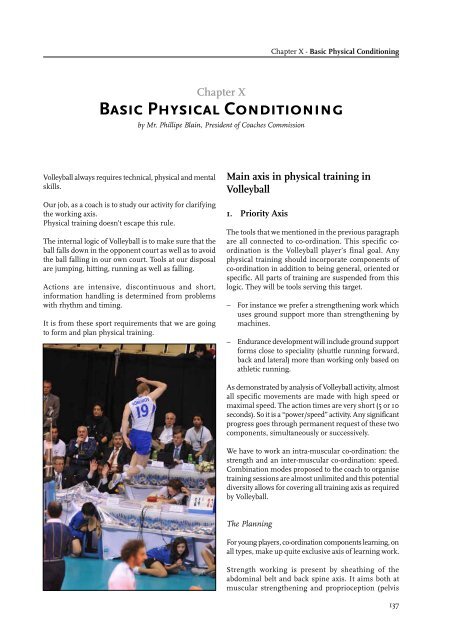COACHES MANUAL
Download
Download
- No tags were found...
You also want an ePaper? Increase the reach of your titles
YUMPU automatically turns print PDFs into web optimized ePapers that Google loves.
Chapter X - Basic Physical Conditioning<br />
Chapter X<br />
Basic Physical Conditioning<br />
by Mr. Phillipe Blain, President of Coaches Commission<br />
Volleyball always requires technical, physical and mental<br />
skills.<br />
Our job, as a coach is to study our activity for clarifying<br />
the working axis.<br />
Physical training doesn’t escape this rule.<br />
The internal logic of Volleyball is to make sure that the<br />
ball falls down in the opponent court as well as to avoid<br />
the ball falling in our own court. Tools at our disposal<br />
are jumping, hitting, running as well as falling.<br />
Actions are intensive, discontinuous and short,<br />
information handling is determined from problems<br />
with rhythm and timing.<br />
It is from these sport requirements that we are going<br />
to form and plan physical training.<br />
Main axis in physical training in<br />
Volleyball<br />
1. Priority Axis<br />
The tools that we mentioned in the previous paragraph<br />
are all connected to co-ordination. This specific coordination<br />
is the Volleyball player’s final goal. Any<br />
physical training should incorporate components of<br />
co-ordination in addition to being general, oriented or<br />
specific. All parts of training are suspended from this<br />
logic. They will be tools serving this target.<br />
––<br />
For instance we prefer a strengthening work which<br />
uses ground support more than strengthening by<br />
machines.<br />
––<br />
Endurance development will include ground support<br />
forms close to speciality (shuttle running forward,<br />
back and lateral) more than working only based on<br />
athletic running.<br />
As demonstrated by analysis of Volleyball activity, almost<br />
all specific movements are made with high speed or<br />
maximal speed. The action times are very short (5 or 10<br />
seconds). So it is a “power/speed” activity. Any significant<br />
progress goes through permanent request of these two<br />
components, simultaneously or successively.<br />
We have to work an intra-muscular co-ordination: the<br />
strength and an inter-muscular co-ordination: speed.<br />
Combination modes proposed to the coach to organise<br />
training sessions are almost unlimited and this potential<br />
diversity allows for covering all training axis as required<br />
by Volleyball.<br />
The Planning<br />
For young players, co-ordination components learning, on<br />
all types, make up quite exclusive axis of learning work.<br />
Strength working is present by sheathing of the<br />
abdominal belt and back spine axis. It aims both at<br />
muscular strengthening and proprioception (pelvis<br />
137



